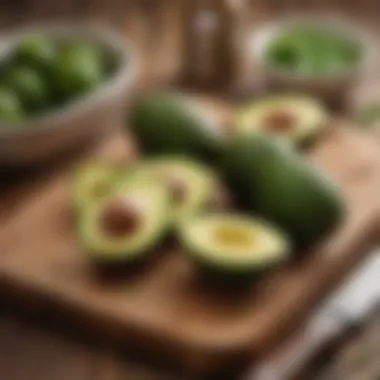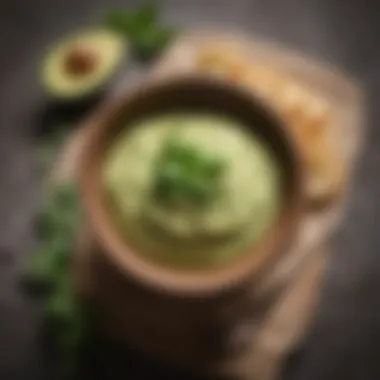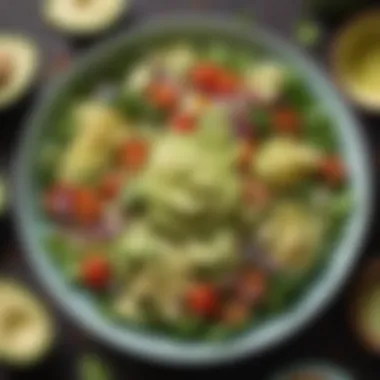Crafting an Easy Avocado Dressing: A Culinary Guide


Recipe Overview
Crafting an easy avocado dressing is not just about combining ingredients; it is an experience of bringing textures and flavors together in a simple yet delightful manner. This dressing is versatile, complementing a variety of dishes—from salads to grilled vegetables.
- Name: Creamy Avocado Dressing
- Yield: 4 servings
- Prep Time: 10 minutes
- Difficulty: Easy
- Main Ingredients:
- Ripe avocados
- Fresh lemon juice
- Olive oil
- Garlic
- Salt and pepper
Step-by-Step Instructions
- Prep the Ingredients: Start by selecting ripe avocados for the best texture and flavor. Cut the avocado in half, remove the pit, and scoop the flesh into a mixing bowl.
- Add Other Ingredients: To the avocado, add 2 tablespoons of fresh lemon juice, 2 tablespoons of olive oil, 1 small minced garlic clove, and a pinch of salt and pepper.
- Blend Until Smooth: Use a fork or an immersion blender to mix everything until you achieve a creamy consistency. Adjust the seasoning to your taste. If the dressing is too thick, add a little water or more lemon juice until you reach your desired consistency.
- Serve or Store: Enjoy immediately or refrigerate in an airtight container. It can last for up to three days if stored properly.
Time-saving Strategies: Consider preparing this dressing in larger batches. A double or triple recipe will enhance its longevity and save time on busy days.
Nutritional Information
This creamy avocado dressing packs a nutritious punch.
- Total Calories per Portion: Approximately 120 calories
- Nutritional Breakdown:
- Proteins: 2g
- Fats: 11g (healthy monounsaturated fats from avocados and olive oil)
- Carbohydrates: 6g
Beneficial Nutrients:
This dressing is rich in vitamins E and C, folate, and potassium. These nutrients contribute to heart health and skin wellness.
Quick Cooking Tips
- Kitchen Gadgets: Using an immersion blender can save time on mixing, ensuring a smooth texture without dirtying multiple appliances.
- Multitasking: While preparing this dressing, you can wash and chop salads or other components for your meal. This keeps the process efficient.
- Healthier Alternatives: For a lighter option, consider substituting Greek yogurt for part of the avocado. This enhances protein content without sacrificing creaminess.
Related Recipes & Variations
- Complementary Recipes: This avocado dressing is excellent on grilled chicken salads or mixed bean salads.
- Dietary Adaptations: For vegan options, ensure no animal products are included in other components of your meal. Add herbs like cilantro or basil to bring new flavor dimensions to the dressing.
Encourage your creativity in the kitchen. Share your twists on this recipe or let us know your favorite ways to use avocado dressing in your meals!
"Avocados are not just ingredients; they are a culinary delight that enhances flavors and promotes health."
This guide provides a solid foundation for crafting a dressing that is not only easy to make but also enjoyable in its use across a spectrum of dishes.
Prelims to Avocado Dressings
Avocado dressings have emerged as a significant player in contemporary culinary practices. This rising trend reflects not only a preference for flavor but also an increased awareness of health and nutrition. The focus on constructing an easy avocado dressing aligns with the necessity for quick yet nutritious meal enhancements. As culinary enthusiasts seek to diversify their dishes without overcomplicating the cooking process, avocado dressings serve as versatile solutions, marrying taste with health benefits.
In this article, we will explore how to craft an easy avocado dressing that can elevate various meals. The simplicity of preparation is paramount, allowing individuals of varying culinary skills to partake in the concoction of this dressing. Ease of use, adaptability to different flavors, and nutritional advantages are just a few elements that will be discussed.
The Growing Popularity of Avocado in Cuisine
The popularity of avocados is notable in recent years. They were once a niche item but are now prominently featured in many dishes across various cuisines. Their creamy texture not only adds depth to recipes but also serves well as a substitute for heavier ingredients. Additionally, diners are increasingly inclined towards plant-based diets, and avocados fit well in this shift due to their rich profiles.
In many places, young chefs and home cooks embrace the fruit’s versatility, incorporating it in salads, sandwiches, and even desserts. The cultural embrace of avocados has led to countless recipes being shared on platforms such as Reddit or Facebook, facilitating discussions about not just the flavor but also preparation techniques. This pervasive enthusiasm has effectively transformed avocados from a simple garnish to a central ingredient in numerous recipes.
Avocado: Nutritional Benefits
Avocados are more than just a culinary delight; they offer a wealth of nutritional benefits. Often touted for their healthy fats, they contain monounsaturated fatty acids that contribute to heart health. Furthermore, they are an excellent source of vitamins such as Vitamin K, Vitamin E, and several B vitamins, including folate. These vitamins play critical roles in maintaining various bodily functions, from blood clotting to energy production.
Moreover, avocados are rich in dietary fiber, which helps support digestive health and can assist in maintaining healthy cholesterol levels. Their low sugar content also makes them suitable for various diet plans, including ketogenic and diabetic diets. As culinary enthusiasts seek to enhance their meals, incorporating avocado dressings not only appeals to taste buds but also promotes overall well-being.


"In essence, adding an avocado dressing to your meal can both satisfy your palate and support your health goals."
Understanding the Core Ingredients
The creation of an easy avocado dressing hinges on a few crucial elements. Understanding these core ingredients is essential for producing a dressing that is both flavorful and nutritious. Each ingredient is not just a placeholder but plays a significant role in the overall taste and consistency of the dressing. This knowledge allows culinary enthusiasts to modify the recipe according to personal preferences, dietary needs, or ingredient availability.
Primary Ingredients for Easy Avocado Dressing
The beauty of avocado dressing lies in its simplicity. The primary ingredients typically include ripe avocados, olive oil, lemon or lime juice, garlic, salt, and pepper.
- Ripe Avocados: The star ingredient, avocados provide a creamy texture and rich flavor. Choosing ripe avocados ensures the dressing is smooth and easy to blend.
- Olive Oil: This adds another layer of flavor and helps achieve a fluid consistency. The healthiest option is extra virgin olive oil, known for its rich taste and nutritional benefits.
- Citrus Juice: Lemon or lime juice is essential for balancing the richness of the avocado. The acidity cuts through the creaminess, adding brightness.
- Garlic: Fresh garlic gives the dressing a kick. It enhances the flavor while providing health benefits.
- Salt and Pepper: These seasonings are necessary for bringing out all the flavors. It is important to taste and adjust as needed.
Each ingredient should be considered carefully, as they contribute not only to the flavor but also to the nutritional profile of the dressing.
Selecting Quality Avocados
Choosing the right avocados is vital when crafting your dressing. Quality avocados can significantly affect both taste and texture. When selecting avocados, look for the following:
- Color: A darker skin often signals ripeness. Avoid those with excessive blemishes or dark spots.
- Firmness: Gently press the skin of the avocado. It should yield slightly under gentle pressure, indicating ripeness without being overly mushy.
- Storage: If avocados are not yet ripe, store them at room temperature. Once ripe, they can be refrigerated for a few days to prolong freshness.
Investing time in selecting quality avocados pays off in flavor, ensuring the dressing isn’t just easy, but also delectable.
Step-by-Step Preparation Process
The preparation process for any culinary creation is critical. In this case, crafting an easy avocado dressing is no exception. This section breaks down the essential steps involved, ensuring that readers can follow along with confidence. Understanding this process not only simplifies the cooking experience but also fosters a sense of accomplishment when one sees the final product.
Basic Recipe Outline
Creating an avocado dressing begins with a basic recipe outline, which serves as the foundation for many variations. A simple yet effective blend is achieved using the following core ingredients:
- Ripe avocados: The star of the dressing. They provide creaminess and a rich flavor.
- Acidic component: This can be lemon juice, lime juice, or vinegar. This ingredient brightens the dressing.
- Seasoning: Salt and pepper are essential for flavor enhancement. Other spices may also be added depending on personal preference.
- Optional liquids: Water or olive oil can be included to adjust the thickness.
To make the dressing, one should begin by mashing or blending the ripe avocados until smooth. Then, add the acidic component and seasonings. Blend again until well combined. Adjustments can be made to suit individual taste. This outline provides a straightforward approach for culinary enthusiasts of all levels.
Blending Techniques for Optimal Texture
The texture of your avocado dressing is key to its appeal. Several blending techniques can be employed to achieve a desired consistency.
- Food processor: This tool is ideal for creating an ultra-smooth texture. Simply combine all ingredients and pulse until blended.
- Immersion blender: This offers convenience, allowing for mixing directly in the serving bowl. It also provides a good texture without transferring ingredients.
- Fork or manual mashing: For those who prefer a chunkier dressing, using a fork to mash the avocado works. This technique gives more control over the dressing's final consistency.
Each method has its merits. The choice depends on the desired texture and the equipment available in your kitchen.
Adjusting Consistency to Preference
Consistency can make or break a dressing. Ideally, it should be thick yet pourable. Adjusting the thickness is quite simple. Here are ways to obtain the perfect result:
- Thickening: If the dressing is too thin, you can add more avocado or reduce the amount of liquid.
- Thinning: To make a thick dressing more pourable, add small amounts of water or olive oil gradually. Blend after each addition.
A well-balanced dressing can elevate any dish, making it crucial to fine-tune this aspect.
By following these steps and techniques, one can successfully craft an easy avocado dressing that is both adaptable and pleasing to the palate.
Exploring Variations of Avocado Dressing
Exploring variations of avocado dressing is essential for anyone looking to diversify their culinary experiences. While the basic avocado dressing serves as a fantastic base, adding different elements allows for personalization that can suit various dishes and preferences. Each variation not only introduces unique flavors but also enhances the nutritional profile of the dressing. By playing with ingredients, culinary enthusiasts can create a dressing that speaks to their individual tastes while elevating everyday meals.


Adding Citrus: A Flavor Boost
Incorporating citrus into avocado dressing is one of the simplest ways to enhance its flavor. Citrus fruits like lime, lemon, or orange provide a well-deserved acidity that balances the creaminess of the avocado. This interaction creates a delightful contrast that can elevate any dish.
The benefits of adding citrus are numerous:
- Brightens the flavor profile: The sharp tang of citrus acts as a counterpoint to the richness of the avocado, making the dressing more lively.
- Enhances freshness: The zesty notes lend a refreshing quality, making it ideal for salads or grilled items.
- Increases nutritional value: Citrus fruits are rich in vitamin C and other antioxidants, which complement the vitamins in avocados. This combination promotes overall health.
To incorporate citrus, start with the juice of one medium lime or lemon. Gradually blend it into the dressing, tasting as you go to find the right balance of acidity.
Incorporating Herbs for Freshness
Utilizing herbs in avocado dressing offers an incredible opportunity to introduce fresh flavors and aromas. Ingredients such as cilantro, parsley, or dill can dramatically shift the taste profile, aligning it to specific culinary styles.
The major advantages include:
- Enhancement of flavor: Fresh herbs add depth and complexity to the dressing, often enhancing the experience of the dish.
- Health benefits: Many herbs have anti-inflammatory properties and provide essential nutrients like vitamins A, C, and K.
When adding herbs, consider roughly chopping them first. About a quarter cup of fresh herbs works well for most recipes. Blend the herbs carefully to ensure an even distribution throughout the dressing.
Spice Options for Increased Heat
For those who enjoy a kick in their dressings, introducing spices is an excellent choice. Options like cayenne pepper, crushed red pepper flakes, or jalapeño can transform the dressing into a zesty accompaniment.
Reasons to integrate spices include:
- Creating a unique profile: Spices can bring an unexpected twist, encouraging creativity and experimentation with each batch.
- Boosting health: Capsaicin found in many spicy ingredients may have metabolism-boosting properties.
To add spices, start by adding a small pinch of cayenne or one finely chopped jalapeño. Gradually increase to match your heat preference without overpowering the dressing.
By exploring these variations of avocado dressing, you can tailor your culinary experiences to suit your palate. Embrace this versatility to make every meal enjoyable!
Practical Applications of Avocado Dressing
Incorporating avocado dressing into meals offers numerous possibilities that enhance flavors and improve nutritional value. This dressing is not merely a topping; it serves as a transformative element for a variety of dishes. Understanding its practical applications elevates its role in everyday cooking. This section will dissect three specific uses of avocado dressing: as a salad enhancer, a drizzle for grilled items, and a pairing for roasted vegetables. Each application showcases how this simple dressing can significantly upgrade meals with minimal effort.
Salad Enhancements
Salads are often seen as a healthy choice but can lack flavor or appeal. Avocado dressing brings an inviting creaminess that balances textures while providing essential nutrients.
- The richness of avocado pairs well with a wide range of ingredients, boosting both taste and satisfaction.
- Using avocado dressing in salads can increase the intake of healthy fats, promoting satiety.
- It complements various salad components, from leafy greens to grains, enhancing the overall meal experience.
When preparing salads, consider using easy avocado dressing in the following ways:
- Use it as a base for a mixed green salad with toppings like cherry tomatoes and cucumber.
- Drizzle over a quinoa salad mixed with black beans and corn for a zesty touch.
- Pair it with roasted beets for a delicious contrast in flavor and visual appeal.
Drizzling Over Grilled Items
Grilling brings out natural flavors, and avocado dressing can amplify this experience. The dressing acts as a finishing touch, adding depth and a creamy texture to grilled dishes.
- Chicken, fish, or even grilled veggies can significantly benefit from a generous drizzle.
- The dressing can be added right after grilling, allowing it to meld slightly with the heat for enhanced flavor absorption.
- It also provides a fresh contrast to charred aspects of grilled foods, making each bite enjoyable.
Helpful tips for using avocado dressing with grilled items:
- Combine it with lime juice for a zesty grilled chicken.
- Use as a topping for grilled fish tacos with fresh toppings.
- Try it with skewered vegetables for a nutritious side.


Pairing with Roasted Vegetables
Roasted vegetables carry a natural sweetness and depth of flavor due to caramelization. Avocado dressing adds a cooling effect and a splash of taste that pairs beautifully with these robust flavors.
- The creaminess of the dressing brings out the best in roasted root vegetables, balancing flavors effortlessly.
- This pairing also aligns with a healthy lifestyle, giving a dose of nutrients without heavy additives.
Consider utilizing avocado dressing with roasted vegetables in the following ways:
- Drizzle it over a medley of roasted carrots, potatoes, and Brussels sprouts.
- Serve it as a dip for roasted cauliflower or eggplant slices.
- Combine it with sweet potatoes for a filling side dish.
"Using avocado dressing with various meals not only enhances flavors but also promotes a healthier food experience."
Storage and Shelf Life Considerations
The optimal storage of avocado dressing is critical. Given its composition, the dressing can deteriorate swiftly if not cared for properly. This section emphasizes essential aspects of storing the dressing to maintain its flavor and nutritional benefits.
Proper storage can prolong the life of the dressing. This allows individuals to enjoy it in multiple meals without frequent preparation. Keeping residual dressing longer may also reduce food waste, a significant benefit in today's culinary practices. Freshness is vital, as avocados can oxidize and spoil more quickly than many other ingredients.
Storing Your Dressing Properly
To ensure your avocado dressing maintains its quality, follow these storage tips:
- Use Airtight Containers: Store the dressing in a container that seals tightly. This minimizes air exposure, which can lead to discoloration and spoilage.
- Refrigeration: Always refrigerate your avocado dressing. The cooler temperature slows the oxidation process, helping preserve both flavor and color.
- Avoiding Metal Containers: Opt for glass or plastic containers instead of metal. Metals can react with the acid in the dressing and may impart unwanted flavors.
- Layering Flavor: Consider placing a thin layer of olive oil on top of the dressing before sealing it. This can create a barrier against air exposure and may prolong freshness.
By adhering to these guidelines, the dressing can last up to a week in the refrigerator without significant compromise in quality.
Identifying Spoilage Signs
Understanding when your avocado dressing has gone bad is crucial. Spoilage can occur unexpectedly, given the perishable nature of its primary ingredient. Here are some signs to look for:
- Discoloration: A shift towards a brownish hue indicates oxidation. While slight discoloration does not always mean spoilage, extensive browning can affect taste.
- Off Odors: Fresh avocado dressing should have a light, pleasant aroma. A sour or rancid smell should alert you to dispose of it.
- Texture Changes: If the dressing becomes unusually thick or has a separated appearance with liquid pooling on top, it may have spoiled.
- Mold Presence: Any visible mold growth is a clear sign of spoilage. In this case, it is best to discard the dressing entirely.
Being mindful of these spoilage signs ensures that you consume only fresh and safe dressing. This awareness aids in making informed culinary choices that enhance your meals without compromising health.
Epilogue and Final Thoughts
Crafting an easy avocado dressing is more than a mere culinary task; it is an exploration of flavors, textures, and health benefits. This dressing's adaptability makes it an ideal companion for various dishes, fitting seamlessly into numerous culinary contexts. By understanding its versatility, one can elevate everyday meals without extensive preparation.
The significance of this dressing lies particularly in its nutritional profile. Avocados provide essential nutrients, promoting heart health and aiding in digestion. The simple act of incorporating this dressing not only enhances flavor but also boosts the overall health of meals. As requested in this guide, making a basic dressing serves as a foundation for creativity. It can move in multiple directions based on personal taste.
Moreover, storage and shelf-life discussions ensure that no dressing goes to waste. The methods outlined provide practical tips on keeping this dressing fresh and enjoyable longer.
"The simplicity of the recipe does not compromise on flavor or health benefits."
It's evident that mastering an avocado dressing is an invitation to culinary experimentation. From basic recipes to complex variations, every cook can discover their style. This concluding section emphasizes how culinary endeavors, even those that are simple, can lead to new experiences in cooking and dining.
The Versatility of Easy Avocado Dressing
The versatility of easy avocado dressing is one of its primary appeals. This dressing complements a vast array of foods, from salads to grilled meats. Its creamy texture and rich flavor profile make it a refreshing contrast to a variety of dishes.
- Salad Dressings: It serves as an ideal base for dressings, whether it’s a simple green salad or a more complex grain salad.
- Dipping Sauce: Many opt to use this dressing as a dip for fresh vegetables or chips, enhancing snacking experiences.
- Spread for Sandwiches: It can effectively replace mayonnaise or other heavy spreads, adding a nutritious twist.
Besides traditional uses, it also adapts well to various cuisine styles. For instance, it complements Mexican dishes or can be used in Mediterranean-inspired spreads. This flexibility invites culinary enthusiasts to approach their meals with confidence. The dressing can be modified to suit dietary preferences or restrictions, maintaining that it remains accessible for everyone.
Encouraging Culinary Experimentation
Encouraging culinary experimentation is vital as it cultivates creativity in the kitchen. The easy avocado dressing is a platform upon which individuals can experiment with flavors and textures. By encouraging modifications to the basic recipe, home cooks can personalize their experience.
Those who wish to expand their culinary horizons can:
- Try Different Ingredients: Adding different herbs or spices alters the flavor profile dramatically.
- Change the Consistency: Adjusting the amount of liquid or fat can result in a thicker or thinner dressing, suitable for various applications.
- Explore Global Flavors: Incorporating international ingredients like miso or tahini can create unique spins on the classic dressing.
This effort to experiment fosters a deeper appreciation for cooking and encourages a lifelong journey through gastronomy. Ultimately, the art of making a simple avocado dressing opens doors to exploration in taste, which can be both fulfilling and delicious.







